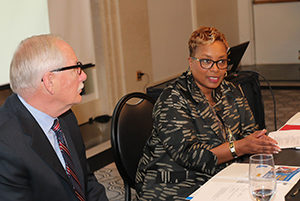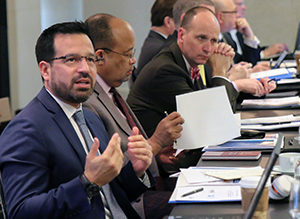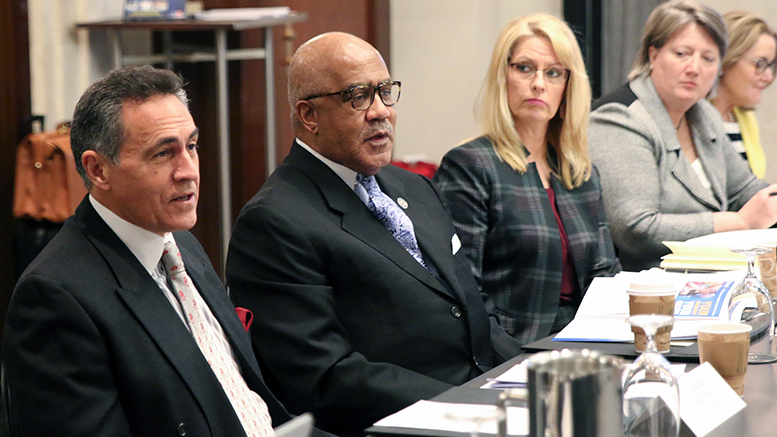Facing a likelihood that federal funding for education will see cuts, community college and K-12 schools plan to look more on local and state levels for support of efforts to better prepare students for college.
As the Trump administration prepares this week to release an outline of its proposed federal budget, community college presidents and school superintendents discussed how they could leverage available resources from localities, states, businesses, foundations and other stakeholders.
The meeting in Washington, D.C., organized by the American Association of Community Colleges and AASA, The School Superintendents Association, focused on how programs such as dual enrollments — which allow high school students to simultaneously take college courses — could receive more support from non-federal sources. Key potential selling points to stakeholders — especially among business and industry in need of skilled workers—could be workforce and economic development.
“The work is going to fall on our shoulders,” said AASA Executive Director Dan Domenech. “It will have to be done on the local level.”
That may seem like a tall order consider competing interest vying for some of the same resources, but community colleges and school districts already are mostly locally financed and they already have relationships in their communities. The success of partnerships on efforts such as dual enrollment depends less on funding and more on willingness to collaborate, he said.

Kevin Maxwell, CEO of Prince George’s County Public Schools in Maryland, and Charlene Dukes, president of Prince George’s Community College, detail their partnership at the AACC/AASA meeting. (Photo: James Minichello/AASA)
Many successful dual enrollment programs already tap local businesses to provide job experience, field experts and funding for scholarships, noted AACC President Walter Bumphus. Such programs developed by Prince George’s Community College and Prince George’s County Public School District in Maryland and Iowa’s Kirkwood Community College and Iowa City Community School District were featured at the meeting.
Attendees noted that the current national attention on jobs could help raise the issue with leaders in business as well as local and state governments.
“Workforce is the thing that’s on everyone’s mind,” said Dianna Phillips, president of Harford Community College in Maryland.
Officials from ACT, which funded the meeting, noted there are three trends helping dual enrollment programs grow in popularity:
- Supporters are raising awareness of dual enrollment among state leaders.
- Dual enrollment is being seen as a workforce development tool.
- Successful programs are creating incentives to encourage teachers to participate.
Federal role

Jose Fierro (left), president/superintendent of Cerritos College in California, poses questions about a pilot program that allows students at selected colleges to use Pell grants to enroll in dual enrollment programs. (Photo: James Minichello/AASA)
Although the prospect for more federal support is unlikely, Congress could look at possibly reallocating some resources as it looks for reauthorize legislation such as the Higher Education Act (HEA), noted Emily Slack, who serves on the staff of the House Education and Workforce Committee. She said the committee — which is chaired by Rep. Virginia Foxx of North Carolina, a former community college president — is open to suggestions from AACC and AASA.
The House committee’s effort to reauthorize HEA is centered around four principles: empowering students and families with information to make more informed decisions; simplifying the federal student aid process; focusing on innovation, action and completion; and ensuring strong accountability and a more limited role for the federal government.
The college and school leaders mulled possibly creating a pilot program that would feature successful dual enrollment programs and how their partners and supporters work together.
More photos from this week’s AACC/AASA meeting in Washington, D.C.
In addition, the group also discussed the shortcomings and potential pitfalls of a current federally funded project that allows qualifying dual enrollment students at selected colleges to use federal Pell grants to pay for their college costs. Although it may seem like a good idea, educators noted that it could have unintended consequences, such as students unknowingly depleting their Pell eligibility or prompting states and other funders that support dual enrollment to withdraw if such program could be funded by the federal government.

